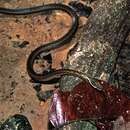en
names in breadcrumbs


Many snakes in the genus Amphiesma are similar in appearance with species boundaries that are not well understood. David et al. (2013) note that Amphiesma khasiense and A. boulengeri have often been confused with each other (as well as with A. inas and other Amphiesma species, such as A. modestum). Amphiesma khasiense was originally described from the Khasi Hills in northeastern India and has long been considered to inhabit a large geographical region, extending from northeastern India, east to Vietnam and southern Thailand (David et al. 2013 and references therein). Amphiesma boulengeri has been considered to be endemic to southeastern China. Amphiesma inas has been recorded in the literature from West Malaysia, Thailand, and Indonesia (Sumatra).
David et al. undertook a multivariate analysis of morphometric and meristic ("countable") characters and found that A. khasiense, A. boulengeri, and A. inascan be separated by combinations of scalation and pattern. Based on their analysis, they concluded that
(1) A. khasiense is actually restricted to northeastern India, Myanmar, western Yunnan (China), northern Laos, and northern and western Thailand. Other populations from southeastern China, Vietnam, other parts of Laos, Cambodia, and central Thailand--which have been recorded in the literature as A. khasiense, A. johannis, or A. modestum--should actually be referred to Amphiesma boulengeri.
(2) Amphiesma inas is a valid species endemic to mountain ranges of southern peninsular Thailand and West Malaysia. The record of A. inas in Sumatra is erroneous, instead being based on the second known specimen of A. kerinciense David & Das, 2003, which is redescribed by David et al. (2013).
David et al. (2013) review the taxonomic and nomenclatural confusion associated with this group of snakes and provide a key to species of the Amphiesma khasiense group and other species sharing a greyish-brown background without conspicuous dark and pale stripes. They provide a technical diagnosis for A. khasiense, which they now recognize as an Indo-Himalayan species which enters the mountain ranges of northern Thailand and northern Laos, and detail combinations of characters that can separate the morphologically similar A. khasiense, A. boulengeri, and A. inas. David et al. note the need for a broad phylogenetic study of Amphiesma that includes molecular characters.
According to David et al. (2013), Amphiesma khasiense is a rather uncommon terrestrial and semi-aquatic species that is active both day and night. It inhabits wet primary submontane and montane forests and wet secondary forests between about 600 and 1,400 m. It is usually associated with the forest floor near the edge of fast flowing mountain streams, but is also present in the vicinity of still waters. It lives mainly among leaves of the forest litter and in the vegetation surrounding water, but has also been found in a rice field located at the edge of a disturbed primary forest and has been observed around a manmade pool surrounded by agricultural fields inhabited by Tylototriton verrucosus newts and various frogs. This snake feeds mainly on small frogs, tadpoles and possibly insects. It is oviparous.
Guo et al. (2014) include Amphiesma khasiense (along with most other species Amphiesma sensus lato) species, in the genus Hebius.